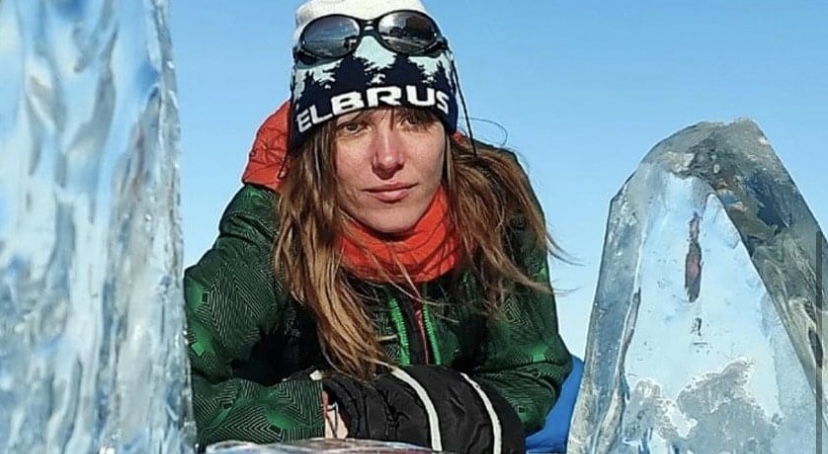This summer, 7,010m Khan Tengri has again shown us how dangerous it is.
At the beginning of August, some mountaineers were in trouble. A woman suffering from vision problems was left alone in Camp 4 while her teammates tried to descend. Finally, another team helped her down.
There were also some climbers alone on the fixed ropes, one of them without gloves at 6,400m. Thankfully, these incidents didn’t take any lives, but a fatality seemed inevitable.

Khan Tengri from the Inylchek Glacier. Photo: Doug Kofsky
Maria Nechaeva’s fatal fall
On August 6, at 12:30 pm, Russian climber Maria Nechaeva fell 300m on one of the northern routes up the peak. This occurred at 5,900m, and climbers found her body at 5,600m. Rescuers took her remains to Base Camp and a helicopter transferred them to the city of Karakol on August 8. Nechaeva had previously climbed Lenin Peak (7,134m).
Accidents on Khan Tengri happen almost every season. The most common cause of fatalities are falls and altitude sickness, but avalanches and hidden crevasses also take lives. Khan Tengri is not an easy mountain.
Summit pushes
During the weather window between August 6 and August 9, several groups of climbers were pushing for Khan Tengri’s summit. Most of the climbers were on the classic route, starting from the southern Inylchek Glacier and climbing the south side of the mountain by the western ridge.
Among them was Polish adventurer and mountaineer Lukasz Supergan. On social media, he recently shared his thoughts about the climb on Khan Tengri.

Lukasz Supergan. Photo: Lukasz Supergan
To complete his acclimatization, Supergan spent one night at Camp 3 on August 5, then descended to Base Camp to rest. The best day to reach the summit was August 7, but he was unable to climb fast enough to take advantage of the weather. So after resting for a single day at Base Camp, he decided to start his summit push, knowing that good weather was still forecast for August 8.
On August 6, Supergan crossed the Inylchek Glacier and reached Camp 1. The next day he climbed directly to Camp 3, overcoming a 1,500m vertical drop. In Camp 3, he decided to head for the summit that night.

The South Inylchek Glacier. Photo: Soderkisen
A risky decision
On August 8, at 2:15 am, Supergan left Camp 3. “The summit ridge was overcast, conditions were a bit discouraging and my acclimatization was not optimal,” he recalled. Even so, he decided to continue.
Supergan started to slow down on the last section of the climb. Despite using handrail fixed ropes, it was necessary to climb very carefully. A complex mix of cracks and difficult mixed terrain made this section dangerous.
At 6,400m, Supergan crossed paths with a retreating team. At 6,600m, where the ridge became a snow couloir, he passed a guide descending with a client. From there, the Polish climber was alone. Soon after, he began to suffer from a lack of oxygen. “I began to fight with my breath for every metre,” he wrote later.
Finally, 13 hours after starting his ascent, he summited Khan Tengri.

Supergan states that the Inylchek Glacier has lost its central section, roughly 50m of thickness over the past 60 years. Photo: Lukasz Supergan
Bad weather arrives
However, bad weather appeared earlier than he expected. The wind picked up and clouds covered the mountain. Supergan began his descent very carefully. He knew that he was not in the best shape because of fatigue, the altitude, and because he had not eaten enough.

On the summit of Khan Tengri. Photo: Lukasz Supergan
Tiredness is very dangerous in the mountains. A poorly measured step or miscalculation of one’s strength can be fatal. By nightfall, making use of the ropes, Supergan was at 6,300m. But he was descending more and more slowly. He became disoriented and sometimes felt that he was falling asleep.
Finally, nine hours after summiting, he reached his tent at Camp 3.

Lukasz Supergan minutes before reaching the summit. Photo: Lukasz Supergan
That night, it began to snow. In the morning, Supergan did not feel up to going down and decided to wait until the following night. His tent was practically buried by the snow, impossible to dig out. He abandoned it in Camp 3, and on August 10 at 2 am, he continued his descent. He slogged through the snowstorm, knowing that if he reached Camp 2 he would have to spend another night there before continuing.
Thankfully, when he arrived at Camp 2, he met a large group led by a guide named Viktor. The group allowed Supergan to use one of their tents, though five people were sharing a tent made for two. Meanwhile, avalanches fell outside.

An avalanche on Khan Tengri in 2021. Photo: Rick Wilton
A risky descent
At 6 pm, they received good news from Base Camp, it was not going to snow anymore during the night. They decided to continue their descent. “We had to descend 1,050m…below the wall of Chapayev Peak, in a high avalanche risk [area].”
They started to hurry down, bound together in three teams. However, after 200m, Supergan felt that his strength had left him. Viktor, the group’s guide, helped him a lot and led the way.
No one should have been descending in these conditions, but staying high could have been fatal for everyone. Therefore, they decided to keep going. On August 11, they made it onto the Inylchek Glacier. But a difficult section still awaited them, more than nine kilometres of dangerous terrain.
The guide led the way, navigating between the cracks. Supergan says that he had to stop every 100 or 200 steps to rest. This last stretch involved a lot of suffering, but at 2 pm, he reached Base Camp.

Khan Tengri, the marble pyramid, at sunset from the southwest. Photo: Ace Kvale
Conclusions
Once down, Supergan thought about what had happened and drew his own conclusions. He believes that he should have spent at least one more day acclimatizing. Without complete acclimatization, his pace slowed, and fatigue kicked in. If he hadn’t been so exhausted after reaching the summit, he could have descended directly to Base Camp, and thus escaped the snow.
Supergan admits that he owes his safe descent to the guide Viktor and his climbing group. With them, he was able to move down from Camp 2. Without them, and without food and fuel, he would have had to spend another night in Camp 2, making the rest of the descent significantly more dangerous. “This time my luck turned out to be people,” he explained.

The most popular routes on Khan Tengri. Photo: Cetneva Spb
Once it was apparent that he’d miss out on the near-perfect August 7 weather window, Supergan believes that he should probably have waited for the next full window. Even if it meant waiting till August 20.
Despite all the obstacles and difficulties, Supergan found enough strength and did not lose control of the situation. His ascent lasted two days and his descent four days.






